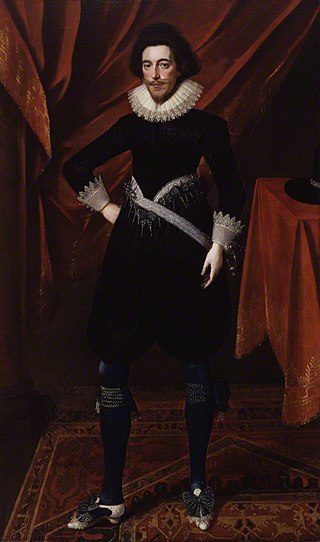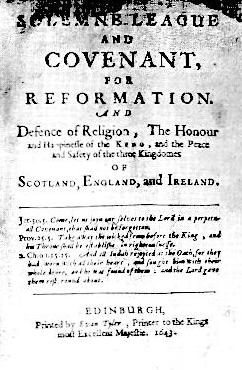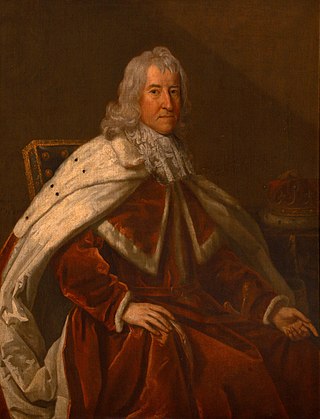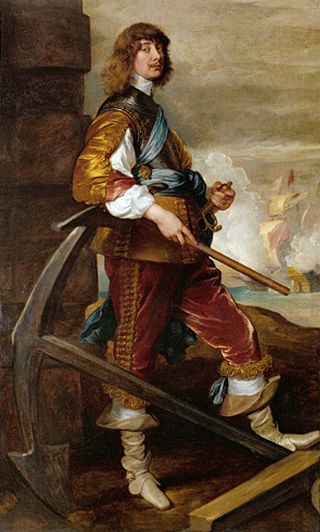Creation
On 9 January 1644 the Estates of Scotland sitting in Edinburgh arranged for a special commission to go to London with full powers to represent the Scottish Estates. [2] The special commission had four members:
- Earl of Loudoun — High Chancellor of Scotland
- Lord Maitland —already in London as Scottish Commissioner to the Westminster Assembly
- Lord Warriston —due in London as a Commissioner to the Westminster Assembly
- Robert Barclay —Provost of Irvine in Ayrshire.
The four Scottish commissioners presented their commission from Scottish Estates to the English Parliament on 5 February. On 16 February, so that the two kingdoms should be "joined in their counsels as well as in their forces", the English Parliament passed an ordinance (Ordinance concerning the Committee of both Kingdoms [3] ) to form a joint "Committee of the Two Kingdoms" to sit with the four Scottish Commissioners. The ordinance named seven members from the House of Lords and fourteen from the House of Commons to sit on the committee and ordained that six were to be a quorum, always in the proportion of one Lord to two Commoners, and of the Scottish Commissioners meeting with them two were to be a quorum. [3]
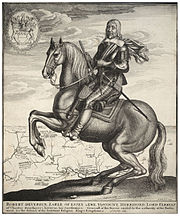
The seven members appointed from among the House of Lords were: [3]
- Algernon, Earl of Northumberland (1602–1668), one of the "peace lords", in 1642 he was dismissed as Lord High Admiral and in 1643 headed the parliamentary delegation to negotiate with the king at Oxford.
- Robert, Earl of Essex (1591–1646), in 1642 became the first Captain-General of the Parliamentary army, but was overshadowed by the ascendancy of Oliver Cromwell and resigned in 1646, dying later the same year.
- Robert, Earl of Warwick (1587–1658), from 1642 Lord High Admiral, appointed by Parliament. In 1648, he captured the Castles of Walmer, Deal, and Sandown for Parliament.
- Edward, Earl of Manchester (1602–1671), in August 1643 was appointed major-general of the parliamentary forces in the east, with Cromwell as his deputy; he was in command at Marston Moor, but later fell out with Cromwell, and in November 1644 opposed continuing the war.
- William, Viscount Saye and Sele (1582–1662), was mainly responsible for passing the Self-denying Ordinance through the House of Lords; and by 1648 wanted a negotiated settlement with the king; he retired into private life after Charles's execution.
- Philip, Lord Wharton (1613–1696), a Puritan and a favourite of Oliver Cromwell, was one of the youngest members of the committee.
- John, Lord Roberts (1606–1685), with the Self-denying Ordinance of April 1645 he lost his command in Plymouth and was sidelined. Shocked by the execution of the king, he withdrew from public life, but after the Restoration he became Lord Privy Seal and later Lord Lieutenant of Ireland.
The fourteen members appointed from the House of Commons were: [3]
- William Pierrepoint (c. 1607–1678), a Member of Parliament for Great Wenlock, represented parliament in negotiations with the king at Oxford in 1643 and at Uxbridge in 1645
- Henry Vane the Elder (1589–1655), a former Secretary of State and a member for Wilton
- Sir Philip Stapleton (1603–1647), a colonel of horse who commanded the Earl of Essex's bodyguard and a brigade of cavalry at the Battle of Edgehill, a member for Boroughbridge
- Sir William Waller (c. 1597–1668), a strict Presbyterian and a major-general of the parliamentary forces, one of the members for Andover
- Sir Gilbert Gerard (1587–1670), a member for Middlesex, paymaster of the Parliamentary army and from 1648 to 1649 Chancellor of the Duchy of Lancaster
- Sir William Airmine (1593–1651), a member for Grantham, later a member of the Council of State
- Sir Arthur Haselrig (1601–1661), a knight of the shire for Leicestershire; following the Restoration he was imprisoned in the Tower of London and died there.
- Henry Vane the Younger (1613–1662), a member for Kingston upon Hull; although he took no part in the regicide, in 1662 he was charged with high treason and beheaded
- John Crew (1598–1679), a member for Brackley and a Justice of the Peace, was later created Baron Crew by King Charles II
- Robert Wallop (1601–1667), a member for Andover, was later one of the Commissioners who sat in judgment at the trial of Charles I
- Oliver St John (c. 1598–1673), a barrister and judge who was married to a cousin of Oliver Cromwell; he was a member for Totnes and became Solicitor General
- Oliver Cromwell (1599–1658), a member for Cambridge, later Lord Protector
- Samuel Browne (c. 1598–1668), a member for Clifton, Dartmouth and Hardness
- Serjeant John Glynne (1602–1666), a member for Westminster and Recorder of London
David Masson states that the Earl of Essex, the Lord General, was opposed to the formation of the committee as it was constituted because "there can be no doubt that the object was that the management of the war should be less in Essex's hands than it had been". [4]



